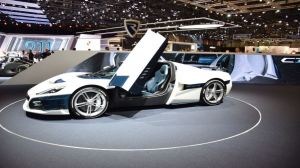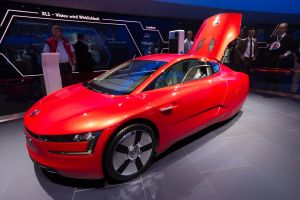Test Owner
Automakers are expected to run assembly lines at slower rates until demand climbs back toward pre-crisis levels.
Europe's car industry, which accounts for about 14 million jobs across the region, is eager to get back to work, even though it's unclear whether buyers will return to showrooms once lockdowns are lifted.
Unlike Italy and Spain, Germany never banned car production, though factories came to a standstill after authorities restricted the movement of people and ordered the closure of car dealerships, hitting demand.
Daimler's Mercedes-Benz German plants in Sindelfingen and Bremen are also making preparations to ramp up production.
Workers need to come to the plant already wearing their factory clothes, to avoid time stuck in changing rooms, and designated pathways in the plant have been altered to ensure there is "one-way" traffic only, BMW said.
Workers need to wear masks and keep a distance to one another. The seating order on BMW factory buses has been changed, as has the process for entering and exiting the bus.
BMW will initially start production at the plants with one shift. Normally, the plants work in two or three shifts. To protect the employees, hygiene and distance regulations are established and processes are reorganized.
BMW's factory in Shenyang, China, has been producing since Feb. 17.
"The exact dates for the restart will depend on the development in the markets and customer demand," a BMW spokesperson said.
The automaker's German plants in Munich, Leipzig and Regensburg will open after May 18, as will the company's factory that builds Mini cars in Oxford, England.
BMW plans to restart output at its biggest European plant in Dingolfing, Germany, and in San Luis Potosi, Mexico, on May 11.
BMW aims to reopen its factory building Rolls-Royce cars in Goodwood, England, on May 4, and resume production at its U.S. plant in Spartanburg, South Carolina, which builds SUVs for global markets, on the same day.
Mini, Rolls-Royce restarts
VW's other plants in Germany and in Portugal, Spain, Russia and the U.S. will restart production in the week from April 27, the automaker said in a news release. Through May, production will be resumed successively in South Africa, Argentina, Brazil and Mexico, VW said.
Encouraged by a fall in infection rates, Germany has allowed small retail stores, including car dealerships, to reopen, provided they adhere to strict distancing and hygiene rules. VW said about 70 percent of its dealerships in Germany had re-opened.
VW resumed production of its battery-powered ID3 hatchback on Thursday. Deliveries of the ID3 are due to start in Europe in the summer. It's a key launch for VW as the first vehicle in its new generation of affordable, long-range electric cars. The automaker's factory in Bratislava, which builds Porsche, VW and Audi large SUVs and minicars, also reopened on Thursday.
Production capacity in the Wolfsburg plant will be at around 10 per cent to 15 percent to begin with, and reach around 40 percent of pre-crisis levels in the week after, said Andreas Tostmann, VW brand's board member responsible for production.
BMW, VW and Daimler, are banking on Germany's ability to trace and contain the coronavirus, and a healthcare system capable of extensive testing to identify possible carriers of the disease.
VW restarted production at its home plant in Wolfsburg on Monday, while BMW is cranking up engine manufacturing, also starting Monday.
BMW and Volkswagen are among European automakers rebooting their car factories to take advantage of easing coronavirus lockdown rules.
Merkel has been talking with the automotive industry, which forms the backbone of the German economy, to find a way to restart production. The talks are focused on automotive suppliers that might not be able to survive extended production shutdowns.
Germany’s automotive lobby group and the country’s largest union called on Chancellor Angela Merkel to allow car sales in the country to resume as soon as possible.
Careers in Construction and Civil Engineering
It’s all about working together. Choose a career in construction and you won’t be starting out on your own. You’ll be joining a team of specialist people all working together to build a strong, long-lasting future. Whatever your role is in the industry, if it’s as a bricklayer or plasterer, civil engineer, architect or construction manager, every team member is as important as the next. So, whether your talent is working with your head or hands, you can be sure there’s a career in construction for you.
Careers in construction aren't limited to the trades you easily recognise on a building site, such as bricklaying, scaffolding or welding - as important as these skills are. For instance, construction projects need managers with the ability to organise people and budgets to ensure tasks are completed on time to the highest quality, as well as supervisors to enforce health and safety rules and security.
"The construction industry gives you the opportunity to create part of the built environment that people can enjoy."
The construction boasts a wide variety of careers including skilled manual labour, project management, IT, marketing, design and much more. Construction needs people with creative, technical, management and practical skills. So, whether you like figuring out how things work, making things with your hands, working in a team, taking charge of projects or you really like designing things, there’s definitely a career for you.
Key benefits of working in construction:
• Be an important part of a team
• Make a real difference to the environment from city regeneration to ensuring essential facilities are available.
• Enjoy a huge variety of work
• The opportunity to work abroad
• Get complete job satisfaction in the knowledge that you helped build something that will last a lifetime or longer
• Give yourself the freedom to start your own business • Start at any level and work your way to the top
• Work towards a range of respected professional qualifications
• Put your creative skills to the test
• Work with your hands and your head
Construction Engineers of all kinds play a vital role in property and construction, as their highly technical skills are required throughout the planning, building, maintenance and preservation stages.
Discover these construction careers and engineering roles:
• Building services engineer
• Construction manager
• Consulting civil engineer
• Contracting civil engineer
• Engineering geologist
• Mining engineer
• Site engineer
• Structural engineer
• Water engineer
There are plenty of institutions offering degrees in construction engineering, for example, Civil Engineering at Oregano State University offers a diverse professional field with areas of concentration in structural engineering, transportation engineering, geotechnical engineering, water resources engineering, surveying, and ocean engineering. The University of Tennessee Knoxville offering career advice on their career portal helping prospects to research career paths, typical job titles, and how to start building skills to get prepared for this industry.
Plenty of UK universities also offer job placements, internships and other career opportunities for prospective civil engineers. As for example, the University of Leeds provides listings for career opportunities in Town and Regional Planning.
Imperial College London – one of the leading universities in the UK offering a variety of programs and career opportunities for international students in civil engineering.
Newcastle University also offering career advice providing insights into the sector listing variety of opportunities - from technical roles to those in management or engineering.
Today Porsche had its annual press conference, remotely of course. Among all the big claims is the one that 2019 was one of the most successful year with sales increase by 10 percent at 280,000 cars globally. The company is planning to pour 15 billion euros into futureproofing its products over the next a couple of years.
Investments will be split between electrifying and digitalising its cars, while a third of it is going into venture capitalism, including its 15 per cent stake in Rimac. Does this mean investment has stopped in good old internal combustion powered cars? Nope. We can hear your sigh of relief from our self-isolation booth.
“We’ll continue with petrol engines in the 911 and improve them step by step,” Porsche CEO Oliver Blume told TopGear.com. “We keep on investing in combustion engines. It’s core to Porsche – especially the 911. We underlined the investment in future technology but we have future investment in internal combustion also.
“We made a very deep analysis of what would be the best opportunity to reduce CO2 in these engines and we’re looking at synthetic fuels.”
These are a carbon-neutral way of powering petrol engines, one which Blume’s team are trialling now.
“We are running tests already with historic cars like the 993, with very good results. The costs are too high at the moment and we haven’t got the ability to produce the fuels in a very sustainable way, so with the help of partners we are looking to produce them with wind or solar. It would be very attractive for cars already in the market.”
Motorsport could be the way to develop them further, where end cost for customers is less of an issue. And it should help justify racing programmes in a company whose entire message is heading towards cutting CO2 at every stage of car production and development.
“Hydrogen – for us – is not useful for sports cars,” added Blume. “You need a lot of space to introduce it and the whole supply chain is complicated. It’s very costly.”
Blume also stressed that the company can reach its goal of 50 per cent electric car sales in 2025 without the help of plug-in 911 and 718 sports cars.
“The 911 isn’t the concept to be fully electrified and our strategy is more to engineer and develop purpose cars which are either 100 per cent electric, or internal combustion combined with hybrid. The 911 is more a concept we can combine with hybrid in future, like we have already done in motorsport with the 919 in the World Endurance Championship.
“This technology can carry over to a 911 with a very powerful hybrid version. With the 718, we haven’t decided which direction we will go in. We are very happy with our current six-cylinder offer in the GTS and GT4. We are working on several concepts. We are very creative and you will see something this year of where we will go with this model range.”
The Boxster and Cayman have a future, though, despite being Porsche’s lowest selling models. “What’s important is that we don’t think about volume – that comes as a consequence of a good product strategy. It’s more important to have tailor-made cars that are special to our customers.”
The fully electric Taycan, meanwhile, is bringing completely new people to Porsche. “We have very traditional customers on one side, who already have a Porsche. But on the other side, around 50 per cent are new customers. They are ‘first movers’ and very interested in sustainability, innovation and digitalisation. And with an average age younger than our traditional customers.”
Original source: Top Gear 2020.
The Global Data Centre market is expecting a steady growth in the upcoming years 2020 -2027, to account for US$ 89.9 Bn in 2027.
The reason for that is a growing demand for green/energy-efficient data center, which is designed to achieve maximum energy efficiency and decreasing the environmental impact.
Ericsson, Deutsche Telekom, Telia Sonera, Telenor, and Tele2 TDC Group along with government agencies are investing a high capital in improving internet connectivity in Western Europe and the Nordic region.
Europe is one of the leading active data center markets, which is expected to grow at a CAGR of 16% during the forecast period. According to the Global Interconnection Index by Equinix Frankfurt, about 70% of the data traffic is concentrated in Germany, France, Italy, Spain, and the UK. London is expected to be the largest interconnection market. Hyperscaleservice providers are actively investing in the Europe data center construction market.
The Europe data center construction market is expected to grow due to increased investments from colocation, cloud, internet, and telecommunication service providers. Further, growth in data, general data protection regulation (GDPR), the popularity of social media, high adoption of smart wearable devices, and the rise of connected reality will be significant growth drivers for Europe data center construction market.
For instance, Amazon is planning to build a US$ 1.08 Bn (Euro 1 Bn) data center in Dublin; IBM plans to open three data centers in UK; also, after two data centers in Ireland and Denmark, Facebook is announced to construct its third data center in Denmark. Furthermore, Interxion has plans to invest US$ 87.8 Mn (Euros 83 Mn) to construct new data center facilities in London, Frankfurt, and Stockholm.
Western Europe (Netherlands, UK, Germany, France), Central and Eastern Europe (Russia and the Czech Republic, Poland and Austria, and other countries, and the Nordic region (Denmark, Finland, Sweden, Iceland, and Norway) are the major contributors to the Europe data center construction market. The UK and the Netherlands are expanding significantly, and the market in the UK is expected to grow at a CAGR of 2% during 2018–2024. Several global cloud service players such as AWS, Microsoft, and Google and many colocation service providers such as Equinix, Digital Realty, CyrusOne, and Colt DCS are expanding their presence in the UK, which is likely to increase the market growth. The implementation of cloud-based and big data services will be a strong growth enabler for the UK data center market, thereby fueling additional investments during the forecast period.
Key Vendor Analysis
Multiple initiatives by hyperscale service providers to reduce the cost of efficient infrastructure services are expected to aid the growth of the Europe data center construction market. Infrastructure resellers and distributors are expected to compete with each other in the region. The demand for cloud data service and high-density operations is expected to grow during the forecast period. Partnerships with local and modular data center service providers will increase revenues for global vendors operating in the market.The need for installation, commissioning, and maintenance services will generate local job opportunities in the market.
Prominent Construction Contractors
• AECOM
• Arup Group
• Bruce Shaw
• Cap Ingelec
• DPR Construction
• Etix Everywhere
• Flex Enclosure
• Future-tech
• Jones Engineering
• KMCS
• LUPP Group
• Mace group
• Mercury engineering
• NCC
• Red Engineering
• Skanska
• SISK Group
• Structure Tone
Prominent Infrastructure Providers
• ABB
• Bosch Security
• Caterpillar
• Cummins
• Eaton
• EURO-DIESEL
• Hitec Power Protection
• KOHLER
• Legrand Group
• MTU OnSite Energy
• Nlyte Software
• Piller Power Systems
• Riello UPS
• Rittal
• Schneider Electric
• Socomec Group
• STULZ
• Vertiv
Prominent Data Center Investors
• Adgar
• Advania Data Center
• Apple
• Aruba
• AWS
• Colt Data Centre Services (Colt DCS)
• CyrusOne
• Digital Realty
• Equinix
• Facebook
• Google
• Global Switch
• Iliad Data Center
• Interxion
• IXcellerate
• Microsoft
• NTT Communications
• OVH
• STT GDC
• T-Systems
• T5 Data Centers
Geneva Motor Show 2020 Preview
This year on the 3rd of March the 90th Geneva International Motor Show will take its place. Over 90 world or European premieres confirmed to be presented on the show with over 150 exhibitors, including everyone’s favorite performance and luxury marques as well as many newcomers.
Approximately 700,000 visitors are expected to cross the floors of the various halls that make up Geneva’s Palexpo convention center. The Motor Authority team will also be covering the show to bring you the latest information and live photos.
Top players will be presented including the following models:
2021 Audi A3: A more high-tech, more dynamic Audi A3 is coming for the 2021 model year and we'll see it for the first time in Geneva. The version to be shown will be the Sportback but the debut of the sedan is likely not far off. The new A3 is more of a heavy update of the current model than a true redesign but there will still be plenty of new tech, including new systems for the all-wheel drive, suspension damping, and speed-sensitive steering.
2021 Aston Martin Vantage: Aston Martin will have an updated Vantage on display. Key among the updates is the new Vantage Roadster body style which looks particularly fetching with the new, more traditional front fascia design that's also being made available for the latest model year. Peak output remains unchanged at 503 horsepower and right now only the coupe is available with a manual transmission, with the Vantage Roadster coming standard with an 8-speed automatic.
Hispano-Suiza Carmen Boulogne: Spain's Hispano-Suiza will show us a new performance variant of its 1,000-plus-hp Carmen electric grand tourer. The Boulogne was developed by Hispano-Suiza's Tailormade personalization department and is said to reference Hispano-Suiza’s racing vehicles from the 1920s, while still retaining the grand touring qualities, including luxury, of the Carmen
Polestar Precept: Polestar will unveil a concept of a large fastback sedan. We mean seriously large, as the wheelbase is six inches longer than the one on the Tesla Model S. The concept hasn't been confirmed for production but we know its design and technology will end up in future models from the Swedish performance EV brand.
2021 Mercedes-Benz E-Class: Mercedes-Benz's popular mid-size sedan, the E-Class, is about to undergo a mid-cycle update and we'll get our first look at the refreshed model in Geneva. There will be revised styling, but of more more significance will be tech updates made to the car. Key among these will be Mercedes' MBUX infotainment system which features a large touchscreen (10.25 inches as standard on the updated E-Class) that can be operated much like a smartphone or tablet.
Source: Motor Authority, 2020
The Company has started building its first mass-market EV, the ID3, in Germany. The compact hatchback will be a rival to Tesla's Model 3, which has helped lift the U.S. automaker's sales in Europe.
While Tesla is paving the way in electric cars, VW is buying software companies and ramping up investments in sustainable vehicles and battery cells, Diess said Friday at the World Economic Forum in Davos, Switzerland.
"It's an open race," Diess said in an interview with Bloomberg TV. "We are quite optimistic that we still can keep the pace with Tesla and also at some stage probably overtake," he said.
Tesla's market value surpassed VW's for the first time this week, even as the U.S. company sells a fraction of the cars VW produces and has yet to record an annual profit.
Still, Tesla has a competitive edge in electric cars and software, technologies that are underpinning a shift toward cleaner mobility.
The threat is underscored by Musk's plan to establish a factory near Berlin, in the heart of Germany's automotive industry.
Diess last week called on his top managers to speed up overhaul efforts to make the company more agile or risk being pushed aside.
"The company which adopts fastest and is most innovative but also which has enough scale in the new world will make the race," Diess said on Friday.
Volkswagen has started building its first mass-market EV, the ID3, in Germany. The compact hatchback will be a rival to Tesla's Model 3, which has helped lift the U.S. automaker's sales in Europe.
U.S. tariffs
Tesla is not Diess's only concern. The CEO was among executives who attended a dinner with U.S. president Donald Trump in Davos on Tuesday. While the meeting was "positive," the threat of U.S. tariffs on European automakers has not been averted, Diess said.
"It's very difficult to read President Trump but he stated that he's still not happy with Europe," Diess said. "We're doing what we can to avoid tariffs."
Volkswagen has been relatively resilient so far to industry headwinds exacerbated by trade friction, higher tariffs and a slowdown in China, the German automaker's largest market. But, the company will have to comply with Europe's new fleet emission targets, Diess said, meaning VW will have to sell more sustainable cars or face penalties.
"2020 for the auto industry will be a very difficult year, " Diess said. "But we're doing the right things to be competitive."
Source: Automotive News, 2020
Sweden – sustainable living as the way of life
The core principle of sustainable development is that members of one generation should act to conserve resources for future generations. For most Swedes today, sustainability is a way of life. Here’s your guide to sustainable living in Sweden.
Living for the future
Sweden ranks first in the EU in consumption of organic foods, leads the way in recycling drinks cans and bottles, and gets the highest share of its energy from renewable sources. What’s more, Swedish fashion retailer H&M is a world leader in using organic cotton and the Government has allocated SEK 400 million for research and development of environment technology.
Green Swedes
In Europe, where the organic food market is growing by 5-7 per cent a year, Sweden ranks at the top of the green shoppers list. A study by the European Commission found that 40 per cent of Swedes had purchased an eco-labeled item in the past month, which is more often than the European average.
In recent years, more stores with organic apparel have opened while established brands have started to use organic fabrics in their collections. According to the organization Textile Exchange, H&M is the world’s largest user of organic cotton.
Vintage fashion
The secondhand clothing market, both in stores and online, is also growing. Vintage fashion is so popular that even established chains are selling second-hand items. Swedish clothing company Weekday sells vintage pieces alongside new apparel, as does fashion store Grandpa. Sweden’s first and only vintage clothing fair, Vintagemässan, started in Stockholm in 2008, and now attracts more than 6,000 people every year.
Recycling leader
Swedes were more conscientious about recycling beverage containers in 2010 than ever before. The target of including 90 per cent of all aluminum cans and PET bottles in the recycling system is close to being reached, today hitting about 88 per cent.
According to recent statistics from Swedish recycling company Returpack, Swedes returned an average of 146 cans and bottles per person for deposit. In recent years, Returpack has introduced a number of measures to get people to recycle more, including doubling the deposit on containers and innovative advertising campaigns, such as Pantamera.
Investing in green technology
In 2011, the Government presented a new environmental technology strategy to establish favourable conditions for the growth and development of environmental technology companies. It had three main objectives:
- promote the export of Swedish environmental technology and thus contribute to sustainable economic growth in Sweden and globally
- promote research and innovation in environmental technology and create the conditions required for green technology companies to flourish in Sweden
- make it easier to commercialise innovations.
The strategy is backed by SEK 400 million in total funding with SEK 100 million allocated each year from 2011 to 2014. Sweden’s environmental technology sector employs roughly 40,000 people and has revenues of about SEK 120 billion, according to Statistics Sweden and the then Swedish Environmental Technology Council.
Source: Sweden.se, 2017
Jobs, technology and lessons of history
If the effects of technology on employment – especially the job-generating qualities – are so unpredictable, are there any durable lessons that can be gleaned from history?
Deloitte analysis from most recent employment data reveals a clear pattern to the way in which technology has affected work. Routine jobs, both cognitive and manual have suffered most, because technology can readily substitute for labour. Job losses in white collar occupations involving the processing of framework and in manufacturing speak to this. By contrast, technology is highly complementary to cognitive, non-routine tasks such as management consultancy where employment growth has been strong.
1. Technology substitute labour as a source of energy
Perhaps the most obvious area is where technology directly substitute human muscle power, in so doing raises productivity and shrinks employment. In the UK, the first sector to feel this effect on any scale was agriculture. In 1871, 6,6% of the workforce of England and Wales were classified as agricultural labourers. Today that has fallen to 0.2%. The same forces have been at work in manufacturing, where the employment rate has fallen from 38% of the workforce in 1948 to 8% in 2012.
2. Jobs are created for the drivers of technology change
Technology directly created jobs in new sectors. In the last 35 years, two of the top ten fastest growing occupations in the UK have been in technology sector. The number of information technology managers has risen by a factor of 6.5, to over 327,000; and the number of programmers and software development professionals has risen by a factor of almost three, to 274,160.
But, history shows this is a dynamic process, in which, in time, technologies become obsolete and are supplanted. The number of people employed as telephone and telegraph operators rose by a factor of forty in the 100 years to 1971. Since then employment has shrunk as automated switchboards, the internet and mobile telephony have taken off.
3. Technology creates jobs in knowledge-intensive sectors
The direct job-creating and job-destroying properties of technology are relatively clear and well understood. What is less obvious is the way in which some technology and knowledge-using sectors combine rising productivity and higher employment over time.
Demand for specialist services, such as medicine, business and professional services, marketing design and education have increased as incomes have risen. These sectors help customers benefit from improvements in specialist knowledge and assist them in navigating complexity. The application of technology to these sectors has risen productivity and improved outcomes. This can be seen most spectacularly in medicine; but easy access to information and the accelerating pace of communication has revolutionized most knowledge-based industries.
4. Technology change lowers expenditure on essentials, creating new demand and jobs
Technology-driven declines in relative prices, often a side-effect to the mechanism described above, increase consumer spending power which, in turn, creates new demand and new jobs. Technological progress allows consumers to meet existing needs at lower cost, enabling them to spend on more discretionary goods and services. Some of these are burgeoning, technology-driven sectors, such as communications and home entertainment. Rising disposable incomes bring what was once the preserve of the well off to a mass market and enable consumers to increase spending on non-essentials. These are the two examples:
a) Despite the decline in traditional pub, data show that the number of people employed in bars rose four-fold between 1951 and 2011.
b) Rising incomes have enabled consumers to spend more on personal services, such as grooming, driving employment of hairdressers. In 1871, there was 1 hairdressers/barber for every 1793 citizens of England and Wales, today there is one for every 287.
Conclusion
Technology has transformed productivity and living standards, and, in process, create new employment in new sectors. Machines will continue to reduce prices, democratising what was once the preserve of the affluent and furnishing the income for increased spending in new and existing areas. Machines will take on more repetitive and laborious tasks but seem no closer to eliminating the need for human labour that at any time in the last 150 years.
History offers important lessons on how technology interacts with employment. And it also points to two central policy challenges. If the pace of adoption of technology is accelerating, society will need to prepare for higher levels of technological unemployment. And the way in which change increasingly rewards high-level education and skills suggests that income inequality may yet widen. Rapid advances in technology mean that education, training and the distribution of income are likely to be central to the political debate for any years to come.












